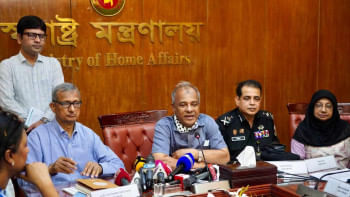An introduction to Kathakali

Clockwise from top: Honoured dancers with organisers at the programme.Malavika Sen strikes a Bharatanatyam stance. T Shankar Narayan during his performance.Photo: Mumit M.
It was a day of mourning: a leading light in the cultural arena, veteran singer Kalim Sharafi, had passed away earlier. But the show must go on, that is the way of the world.
As a finale to a recent workshop on Kathakali dance (first in Bangladesh) jointly arranged by Shanto Marium University of Creative Technology and Bangladesh Shilpakala Academy (BSA), presentations highlighting the dance form were staged at the National Theatre Hall, BSA on November 2. Seven renowned dancers of Bangladesh were also honoured at the event.
The workshop was held at Shanto Marium University of Creative Technology from October 26 to 31 and was conducted by Guru T Shankar Narayan (former professor, Sangeet Bhaban, Visvabharati University, India).
Minister of Information and Culture, Abul Kalam Azad, was the chief guest. Among the special guests were Shipping Minister Shahjahan Khan; Deputy High Commissioner of India Sanjay Bhattacharya; Secretary to the Ministry of Information Hedayetullah Al Mamun; Vice Chancellor of Shanto Marium University of Creative Technology Dr. Shamsul Haque and noted Bharatanatyam guru from India, Thankamani Kutty.
The presentation started off with a group demonstration -- led by Tamanna Rahman -- of basic Kathakali moves.
Kathakali is the most well known performing art form from the south Indian state of Kerala. The word “Kathakali” literally means “story-play”. This highly stylised classical Indian dance-drama is noted for it's particular code of make-up, elaborate costumes, detailed gestures and well-defined movements. It originated in the 17th century. Kathakali performances are traditionally based on themes from Hindu mythology, especially the two epics -- “Ramayan” and “Mahabharat”.
The main facial expressions of a Kathakali artiste are the navarasams (nine emotions): Sringaram (amour or seduction), Hasyam (humour), Bhayanakam (fear), Karunam (pathos), Roudram (anger), Veeram (valour), Beebhatsam (disgust), Adbhutam (amazement) and Shantam (calmness).
These expressions were magnificently illustrated by Guru T Shankar Narayan as he took the stage in the avatar of Damayanti. As heroine of the “Nala-Damayanti” episode from the epic “Mahabharat”, Shankar delivered a performance that generated rounds of applause.
Following the Kathakali make-up code, the dancer had a yellowish face. According to the code, the faces of noble male characters are predominantly green. Characters of high birth with an evil streak, such as the demon king Ravan, are allotted a similar green make-up, slashed with red marks on the cheeks. Extremely evil characters wear red make-up and a flowing red beard. Women and ascetics have lustrous, yellow faces.
Through delicate, restrained and powerful facial and hand gestures, the veteran performer brought to life the tale of the star-crossed lovers.
Another highlight was a Bharatanatyam performance by Malavika Sen. The act, “Padam” was a homage to Lord Shiva and his wife, eternal companion Parvati.
At the programme Shanto Marium University of Creative Technology also honoured seasoned Bangladeshi dancers Shaju Ahmed, Dr. Shoma Mumtaz, Shukla Sarkar, Shibli Muhammad, Shamim Ara Nipa, Munmun Ahmed and Tamanna Rahman. Chairman of Shanto Marium Foundation Md. Imamul Kabir Shanto handed the crests to the artistes.
Many in the audience, however, could not enjoy all the dance performances. The shared grievance was that they had to wait over an hour and half for the recital to begin. The tradition of never-ending speeches and seemingly pointless formalities at cultural programmes need to be curbed.

 For all latest news, follow The Daily Star's Google News channel.
For all latest news, follow The Daily Star's Google News channel. 



Comments